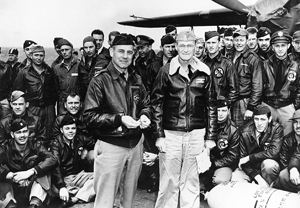In the midst of nationwide protests and the tearing down of Confederate statues last year, President Donald J. Trump promised to build a “National Garden of American Heroes.” On Jan. 18, he revised his July executive order and listed out the luminaries he hopes to honor, among them aviation and aerospace pioneers including Benjamin O. Davis Jr., James H. “Jimmy” Doolittle, Neil Armstrong, John Glenn, and William “Billy” Mitchell—to name just a few.
The memorial garden is unfunded and would require the support of Congress, which has the power to quash the idea. The original vision named few aviation or space heroes, except for the Wright Brothers, Amelia Earhart, and schoolteacher-turned-astronaut Christa McAuliffe, who died in the Challenger disaster.
The revised list includes:
- Davis, who commanded the Tuskegee Airmen during World War II and went on to become the Air Force’s first-ever Black general officer
- Doolittle, an Army Air Forces lieutenant colonel who led the April 18, 1942 raid on Tokyo, which pioneered the concept of global strike and the idea that no target on Earth is safe from U.S. air power. Doolittle also is the namesake of the Air Force Association’s Doolittle Leadership Center headquarters building.
- Col. Francis “Gabby” Gabreski, whose 28 mid-air victories during World War II made him the highest-scoring ace in Europe during the conflict, as Walter J. Boyne recounted for Air Force Magazine in 2005.
This edition of the “Air Force Report” features a story on Lt. Gen. Terry Gabreski’s visit to Osan Air Base, South Korea, to remember her father-in-law, Col. Francis Gabreski. Video: USAF
- Mitchell, a World War I air commander and early advocate of strategic bombing, as well as the namesake of AFA’s Mitchell Institute for Aerospace Studies think tank.

In addition to these giants, Armstrong, the first man to set foot on the moon; Glenn, the first U.S. citizen to orbit the planet; Sally Ride, the first U.S. woman to go to space; and World War II veteran and U.S. Navy test pilot-turned-astronaut Alan Shepard, the first American to go to space—are now slated to join McAuliffe in the select fraternity of space greats honored within the park.
If the garden is built, it’s unclear where it might be located. That, too, would require approval from others. In his original July 3, 2020, executive order, Trump noted “the National Garden should be located on a site of natural beauty that enables visitors to enjoy nature, walk among the statues, and be inspired to learn about great figures of America’s history.”
